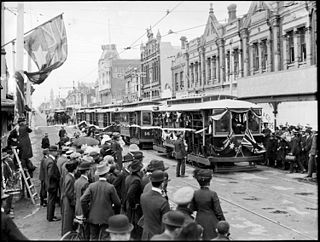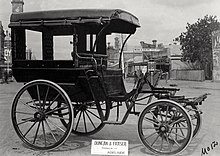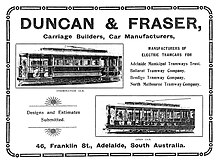
McLaughlin Motor Car Company Limited was a Canadian manufacturer of automobiles headquartered in Oshawa, Ontario. Founded by Robert McLaughlin, it once was the largest carriage manufacturing factory in the British Empire.

Studebaker was an American wagon and automobile manufacturer based in South Bend, Indiana, with a building at 1600 Broadway, Times Square, Midtown Manhattan, New York City. Founded in 1852 and incorporated in 1868 as the Studebaker Brothers Manufacturing Company, the firm was originally a coachbuilder, manufacturing wagons, buggies, carriages and harnesses.
The Tramway Museum Society of Victoria Incorporated (TMSV) owns a large collection of trams from Melbourne, Ballarat, Geelong, Adelaide, and Sydney as well as preserved buses and other work vehicles.

Bristol Commercial Vehicles was a vehicle manufacturer located in Bristol, England. Most production was of buses but trucks and railbus chassis were also built.

Until 1958, trams formed a network spanning most of Adelaide, with a history dating back to 1878. Adelaide ran horse trams from 1878 to 1914 and electric trams from 1909, but has primarily relied on buses for public transport since the mid-20th century. Electric trams, and later trolleybuses, were Adelaide's main method of public transport throughout the life of the electric tram network. The tram network was progressively closed down through the 1950s with the last lines closing in 1958; the Glenelg tram line was the only line to survive these closures and has remained in operation ever since and has been progressively upgraded and extended since 2005.

The Prahran and Malvern Tramways Trust (PMTT) was a former tram operator in Melbourne, Australia. The trust was formed in 1907, with its first line operating in 1910. Its functions were taken over by the Melbourne & Metropolitan Tramways Board in 1920.
The Hawthorn Tramways Trust was a tram operator in Melbourne, Australia. Its assets and liabilities were transferred to the Melbourne & Metropolitan Tramways Board on 2 February 1920.

The earliest trams in Australia operated in the latter decades of the 19th century, hauled by horses or "steam tram motors". At the turn of the 20th century, propulsion almost universally turned to electrification, although cable trams lingered in Melbourne. In cities and towns that had trams, they were a major part of public transport assets.

A substantial car industry was created in Australia in the 20th century through the opening of Australian plants by international manufacturers. The first major carmaker was Ford Australia and the first Australian-designed mass production car was manufactured by Holden in 1948. Australian manufacture of cars rose to a maximum of almost half a million in the 1970s and still exceeded 400,000 in 2004. Australia was best known for the design and production of 'large' sized passenger vehicles. By 2009 total production had fallen to around 175,000 and the Australian market was dominated by cars imported from Asia and Europe.

The city of Geelong in Victoria, Australia, operated an extensive tramway system from 1912 until 1956, when the service was replaced by buses. Unlike Victoria's other major regional cities, Ballarat and Bendigo, which have kept some track and trams as tourist attractions, no trams or tracks remain in Geelong.

The Ballarat Tramway Museum is an operating tramway museum, located in Ballarat, Victoria, Australia. The museum is run by volunteers and has a fleet of trams which operate on part of the original horse tramway around Lake Wendouree and the Botanical Gardens. It has a large research collection, archive of information and more than 3,500 items about the Ballarat tramways. The trams in Ballarat operated on a large network through the city from 1887 until 1971.
Lewis Thornet Bandt was an Australian car designer, most famous for designing and building the first ute cars in the 1930s.

The C-class was a group of 11 trams built by Duncan & Fraser, Adelaide for the Prahran & Malvern Tramways Trust (P&MTT) in 1913, numbered 25 to 35. All retained their fleet numbers when passed to the Melbourne & Metropolitan Tramways Board (M&MTB) on 2 February 1920, after it took over the P&MTT. They were designated C-class sometime after October 1921, and by late 1923, all M&MTB drop-end-and-centre Maximum Traction trams were grouped together as C-class trams. The 22E Maximum Traction trucks were of JG Brill design, although manufactured by Brush in England.

The E-class was a group of 10 trams built by Duncan & Fraser, Adelaide, for the Prahran & Malvern Tramways Trust (P&MTT) in 1914, numbered 36 to 45. Number 36 was converted to a different form by the P&MTT circa 1916, and was later designated D-class. All retained their fleet numbers when passed to the Melbourne & Metropolitan Tramways Board (M&MTB) after it took over the P&MTT on 2 February 1920, and they were designated E-class sometime after October 1921. By late 1923, together with other all M&MTB drop-end-and-centre Maximum Traction trams, they were re-classed as C-class trams. The 22E Maximum Traction trucks were of JG Brill design, although manufactured by Brush in England.
The O-class Melbourne tram were a group of four trams built in 1912 by Duncan & Fraser (Adelaide) for the Prahran & Malvern Tramways Trust (P&MTT) upon the recommendation of W. G. T. Goodman, Chief Engineer and General manager of the Adelaide tramways. They were allocated P&MTT fleet numbers 21 to 24. At the time of their introduction, they were by far the largest street-vehicles in Melbourne, and earned the nicknames Zeppelins and Dreadnoughts. Proving to be less than satisfactory in service, they were later sold to the Hawthorn Tramways Trust (HTT) in August 1916 as "surplus to requirements", however P&MTT soon ordered replacement tramcars. Coincidentally they retained their fleet numbers whilst at Hawthorn.

The Tramway Museum, St Kilda is Australia's principal museum of the 19th and 20th century trams of Adelaide, South Australia. It is situated at St Kilda, 24 kilometres north of the centre of Adelaide. It is operated by the Australian Electric Transport Museum (SA) Inc., a not-for-profit volunteer organisation affiliated with the Council of Tramway Museums of Australasia. It is dedicated to the study, conservation and restoration of trams that were used in Adelaide or built there, and likewise with a small bus and trolleybus collection. Trams provide rides for visitors along a 1.6 km (1.0 mi) purpose-built track between the museum and a large adventure playground.
This article describes the tram types in Adelaide that have operated for the past 144 years: from early days when they undertook a major share of the public transport task before car ownership was well established; through the 49-year period when only one tram line operated; to the city's 21st-century tramways revival.
The Adelaide D type tram was a class of trams operated by the Municipal Tramways Trust on the Adelaide tram network from 1910 until 1958.

A Pengelly & Co was an Australian furniture manufacturer, motor car and rolling stock body maker in Adelaide, Australia. It had a three acre factory on South Road, Edwardstown.
























